
The Navajo-Churro, or Churro for short, is a breed of domestic sheep originating with the Spanish Churra sheep obtained by the Diné around the 16th century during the Spanish Conquest. Its wool consists of a protective topcoat and soft undercoat. Some rams have four fully developed horns, a trait shared with few other breeds in the world. The breed is highly resistant to disease. Ewes often birth twins, and they have good mothering instincts. This breed is raised primarily for wool, although some also eat their meat.

The Border Leicester is a British breed of sheep. It is a polled, long-wool sheep and is considered a dual-purpose breed as it is reared both for meat and for wool. The sheep are large but docile. They have been exported to other sheep-producing regions, including Australia and the United States.

The Jacob is a British breed of domestic sheep. It combines two characteristics unusual in sheep: it is piebald—dark-coloured with areas of white wool—and it is often polycerate or multi-horned. It most commonly has four horns. The origin of the breed is not known; broken-coloured polycerate sheep were present in England by the middle of the seventeenth century, and were widespread a century later. A breed society was formed in 1969, and a flock book was published from 1972.
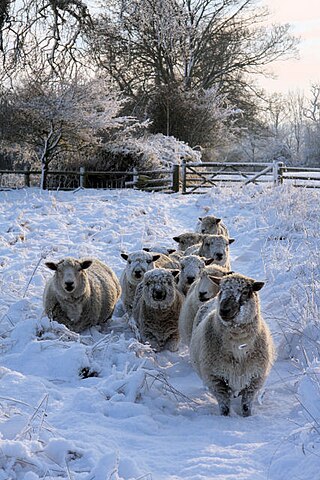
The Ryeland is one of the oldest English sheep breeds going back seven centuries when the monks of Leominster in Herefordshire bred sheep and grazed them on the rye pastures, giving them their name. It was introduced into Australia in 1919 and are classified as an endangered breed by the Rare Breeds Trust of Australia and also are one of the nine heritage breeds that were the foundation of the sheep and wool industry in Australia. The Ryeland was one of the breeds used to introduce the poll gene to the Dorset breed in the development of the Poll Dorset. This breed is raised primarily for meat.

The Suffolk is a British breed of domestic sheep. It originated in the late eighteenth century in the area of Bury St. Edmunds in Suffolk, as a result of cross-breeding when Norfolk Horn ewes were put to improved Southdown rams. It is a polled, black-faced breed, and is raised primarily for its meat. It has been exported to many countries, and is among the most numerous breeds of sheep worldwide.

The Dorper is a South African breed of domestic sheep developed by crossing Dorset Horn and the Blackhead Persian sheep. The breed was created through the efforts of the South African Department of Agriculture to breed a meat sheep suitable to the more arid regions of the country. It is now farmed in other areas as well, and is the second most common sheep breed in South Africa.

The Southdown is a British breed of domestic sheep, the smallest of the British breeds. It is a shortwool breed, and the basis of the whole Down group of breeds. It was originally bred by John Ellman of Glynde, near Lewes in East Sussex, in about 1800. It has been exported to many countries; it has been of particular importance in New Zealand, where it was used in the breeding of Canterbury lamb. In the twenty-first century it is kept principally as a terminal sire.

The Romney, formerly called the Romney Marsh sheep but generally referred to by the local farmers as the Kent, is a breed of sheep originating in England. The Romney is a "long-wool" breed recognized in England by 1800. Exported to other continents, the Romney is an economically important sheep breed, especially to the sheep-meat and wool export trades of New Zealand.
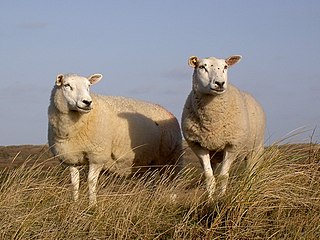
The Texel is a Dutch breed of domestic sheep originally from the island of Texel. It is a heavy and muscular sheep, and produces a lean meat carcass. It is polled, clean-faced and clean-legged, with white face and wool. The fibre diameter of the wool averages about 32 μ, with a staple length of 8–15 cm; it is used mainly for knitting and hosiery wools.

The Dorset Horn is an endangered British breed of domestic sheep. It is documented from the seventeenth century, and is highly prolific, sometimes producing two lambing seasons per year. Among British sheep, it is the only breed capable of breeding throughout the winter.
The Polypay sheep breed is a white, medium-sized, polled sheep which was developed in the 1960s at the U.S. Sheep Experiment Station in Dubois, Idaho. In general, Polypay sheep are noted for being a highly prolific maternal dual-purpose breed. It produces yearly about 4.2 kg of wool and is weaned at 120 days.

The Coolalee is an Australian short wool, meat sheep breed, developed from an eight-year breeding program commenced in 1968. The breed resulted from the crossing of the Wiltshire Horn, Suffolk, Hampshire Down, Poll Dorset, Lincoln and English Leicester sheep breeds.

The Charollais is a breed of domestic sheep originating in east central France, in the same region in which Charolais cattle originated, Charolles and Saône-et-Loire. It is known for ease of lambing and is used as a terminal sire to increase muscling and growth rate of the lambs. It has been exported internationally, and is commonly used in the United Kingdom as a sire to produce market lambs from pure-bred ewes and mules.
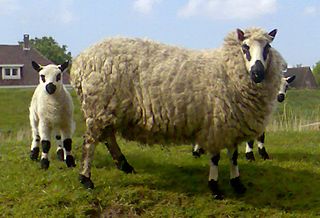
The Kerry Hill is a breed of domestic sheep originating in the county of Powys in Wales. It derives its name from the village of Kerry (Ceri), near Newtown. Kerry Hill sheep have a distinctive and unique coloration, with a white face bearing black markings around the mouth, ears, and eyes. Both rams and ewes are polled. Their wool is white, and their legs are white with black markings. First mentions of the breed date back to the early 19th century, and today it is distributed throughout the United Kingdom, Ireland, the Netherlands, Germany and Denmark. Though still not very numerous, the breed was removed from the records of the Rare Breeds Survival Trust watchlist in 2006. This breed is primarily raised for meat.
The Devon Closewool is a British breed of domestic sheep. It is distributed almost exclusively on Exmoor in North Devon, in south-west England. It is raised primarily for meat.
The British Milksheep is a robust, dual-purpose sheep commonly known for its milking characteristics.

The Wiltipoll is a breed of polled domestic sheep that was developed in Australia from Wiltshire Horn sheep with the infusion of Border Leicester, Perendale, Poll Dorset, and Poll Merino genetics, that are raised for meat.
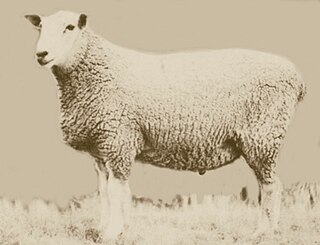
Gromark sheep are a large-framed, plain bodied dual-purpose breed of sheep that were under development in 1965 by Arthur C. Godlee at "Marengo", Tamworth, New South Wales. They were selected for a high growth rate, fertility, wool quality and carcase attributes.
The Eliottdale is a breed of domestic sheep originating from Tasmania. It is a carpet wool breed raised primarily for its wool. Due to the amount of wool grown by the Eliottdale, it needs to be shorn twice per year.
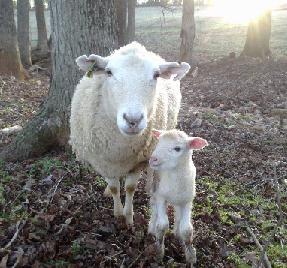
The Polled Dorset is an American breed of domestic sheep. It is a polled (hornless) variant of the British Dorset Horn. It was developed at the North Carolina State University Small Ruminant Unit in the 1950s after a genetic mutation led to the birth of a polled ram. After some years of breeding work, a true-breeding polled strain was established.
















